It's breakfast time, and I am about to spread some honey on my toast. I am using a spoon to dip in the honey jar. A magnified view of the leading edge of the spoon as it scoops up the honey might be like the picture below. This is a rather blunt-edged spoon, but the flow streamlines for a sharp edge would be similar. Actually, I computed these streamlines for flow about the leading edge of a hydrofoil or submarine. In that case the corners need smoothing to make the flow realistic; but that's another story.
![]()
Figure 1: Flow streamlines in a viscous fluid.
Now let's return to breakfast. I've got the honey on my spoon, and am fascinated by its slow-moving viscous behaviour. I lift the spoon high, and turn it upside down, watching for the honey to fall onto my toast. It takes a few seconds before it moves very much at all, but then it falls in a rush, as I now demonstrate.
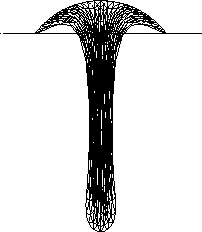
Figure 2: Calculated shape of a drop of viscous fluid.
Next I show a video of the same honey-falling flow. This video is not a close-up of the actual demonstration, but is a computer simulation. It was prepared by my PhD student Yvonne Stokes, using a ‘finite-element’ program. This was actually designed to be used with some industrial applications. Yvonne's main work is on the slumping of molten glass into a mould, which is a very important process in the optical industry. Anyway, the computation is clearly seen to be a very good model of actual flow of honey. The final fall occurs so rapidly that we need to split the screen; a compressed image allows more of the final fall to be seen. The previous picture shows a single frame from this video.
For the rest of this talk, I want to illustrate how very simple Year-12 level
calculus can throw some light on this sudden-fall phenomenon.
The next picture
shows a snapshot of the honey-drop during its fall. I am going to be daring
enough to ask you to appreciate some algebraic symbols, introducing the symbol
![]() to denote the length of the drop. Also I will use the symbol
to denote the length of the drop. Also I will use the symbol ![]() in the
obvious way to denote the time. The question is, how does length
in the
obvious way to denote the time. The question is, how does length ![]() vary with
time
vary with
time ![]() ?
?
Calculus is about rates of change.
For example, if the rate of change of ![]() with
respect to
with
respect to ![]() was constant
then
was constant
then ![]() would increase steadily (linearly) with time,
as in the graph below.
Obviously that is not what happens here!
Rather than a steady increase, the honey seems hardly to
move at all at first, then falls very suddenly.
would increase steadily (linearly) with time,
as in the graph below.
Obviously that is not what happens here!
Rather than a steady increase, the honey seems hardly to
move at all at first, then falls very suddenly.
Think of ![]() also as like the amount of money in your savings bank account.
Constant rate of change is like simple interest. On the other hand, compound
interest is where the rate of change increases as
also as like the amount of money in your savings bank account.
Constant rate of change is like simple interest. On the other hand, compound
interest is where the rate of change increases as ![]() increases, and your bank
balance then increases faster than it would for simple interest.
For small compounding intervals this increase is exponential,
as below.
`Exponential',
as a word describing rapid increases in the size of something like population,
is in quite common use these days.
Its explicit meaning, via the actual exponential function
increases, and your bank
balance then increases faster than it would for simple interest.
For small compounding intervals this increase is exponential,
as below.
`Exponential',
as a word describing rapid increases in the size of something like population,
is in quite common use these days.
Its explicit meaning, via the actual exponential function ![]() ,
is well known to every Year-12 student of
Mathematics, Physics, and especially Biology.
,
is well known to every Year-12 student of
Mathematics, Physics, and especially Biology.
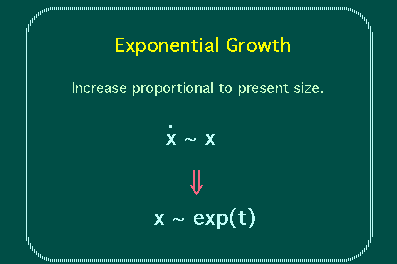
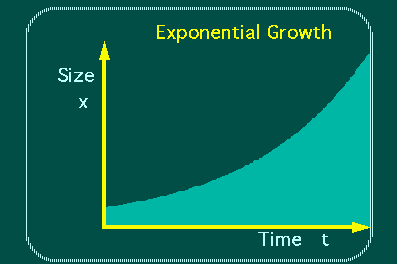
![]() measures population size, then the rate of
increase of
measures population size, then the rate of
increase of ![]() is proportional to the present value of
is proportional to the present value of ![]() .
Malthus's law of exponential population growth is a famous biological result meaning that the
population increases ``for ever''. Of course some other effect like food
limitation will eventually intervene to slow down this increase. Similarly, if
exponential growth really did apply to honey falling, the length
.
Malthus's law of exponential population growth is a famous biological result meaning that the
population increases ``for ever''. Of course some other effect like food
limitation will eventually intervene to slow down this increase. Similarly, if
exponential growth really did apply to honey falling, the length ![]() of the drop
would apparently increase for ever. Fortunately the toast eventually gets in
the way!
of the drop
would apparently increase for ever. Fortunately the toast eventually gets in
the way!
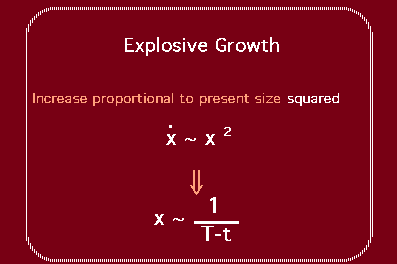
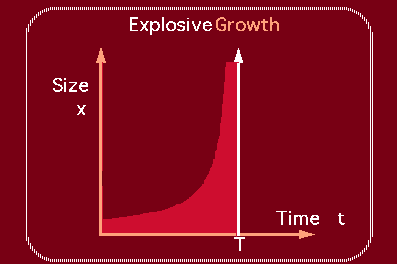
![]() is not just in proportion to the present length
is not just in proportion to the present length ![]() ,
but in proportion to the square of that length,
as above.
,
but in proportion to the square of that length,
as above.
Every Year-12 mathematics student can (or should be able to!) solve the
differential equation for explosive growth.
It is actually a bit easier than that for exponential growth.
The answer is just that ![]() behaves like the
reciprocal of a time difference. The most important consequence is that there is a finite
time
behaves like the
reciprocal of a time difference. The most important consequence is that there is a finite
time ![]() at which
at which ![]() becomes infinite! This is the time when the explosion
actually happens, or the time when the honey really falls.
The previous picture shows a graph of
becomes infinite! This is the time when the explosion
actually happens, or the time when the honey really falls.
The previous picture shows a graph of ![]() against
against ![]() .
.
Even for exponential growth ![]() eventually becomes infinite,
but only if you wait an infinite time.
With explosive growth you don't have to wait an infinite time.
The same practical qualification prevents an actual infinite value
of
eventually becomes infinite,
but only if you wait an infinite time.
With explosive growth you don't have to wait an infinite time.
The same practical qualification prevents an actual infinite value
of ![]() from occurring; namely, the honey hits the toast.
from occurring; namely, the honey hits the toast.
Explosive growth naturally occurs for real explosions too.
For example, here is a slide
of the Mt St Helens explosion of May 1980.
(Photograph by Austin Post, USGS; reproduced from the collection of images available at the Cascades Volcano Observatory.)

Prior to that explosion, there was a build up over several weeks of a mound of volcanic material, as shown at left. This was like the preliminary drooping of the honey in the spoon, before it really gets moving.
(Photograph by Peter W Lipman, USGS; from the Cascades Volcano Observatory.)
The dome on Mt St Helens, was growing at up to 1.5m per day.
From the technical point of view,
there is immense interest in the actual value of the explosion time ![]() .
If
.
If ![]() was known for Mount St Helens, lives could have been saved.
Indeed, the earthquake prediction business is precisely about this
was known for Mount St Helens, lives could have been saved.
Indeed, the earthquake prediction business is precisely about this ![]() estimation.
For the honey drop, we can predict
estimation.
For the honey drop, we can predict ![]() quite well.
For example,
quite well.
For example, ![]() is proportional to the viscosity of the
honey. Obviously thicker honey takes longer to fall.
is proportional to the viscosity of the
honey. Obviously thicker honey takes longer to fall.
This type of study is typical of Applied Mathematics.
Although the honey problem may seem rather trivial or silly,
I hope you can see the important practical generalisations,
some of which require only very elementary mathematics.
![]()
This electronic document has been modified
from that constructed by
Ross Moore
for the
National Symposium in Mathematics, UNSW, 23 February 1996.
Thu 30 Jan 1997; Tue 24 April 2012.